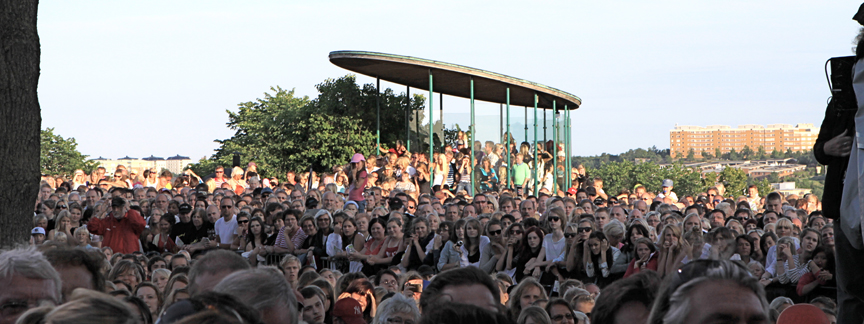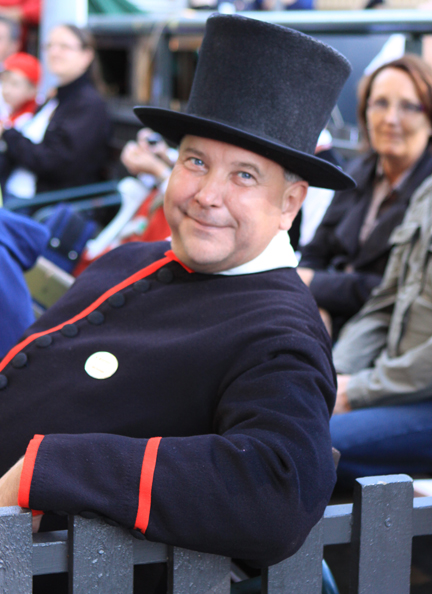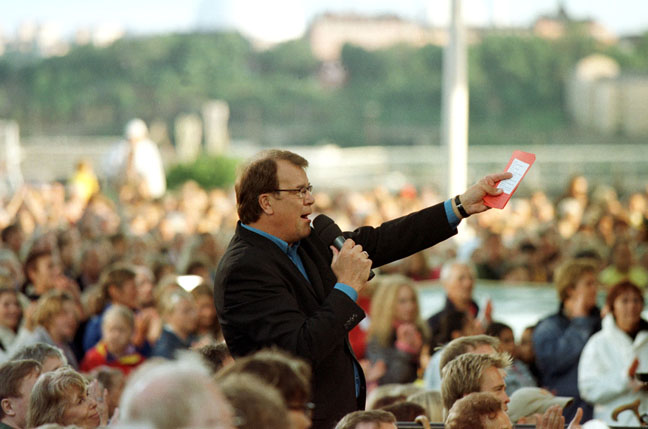Singing as a Bearer of Culture
Most Scandinavians grow up singing, and when it comes to organized singing, maybe more so in Sweden than anywhere else.
-
 The final 'Allsång' this year was August 4, with a record audience, on site and in front of TVs. (The total audience varies but is seldom under 1.2 million viewers, more often over 2 million... in a country of only 9 million total.) Photo: Kerstin Alm
The final 'Allsång' this year was August 4, with a record audience, on site and in front of TVs. (The total audience varies but is seldom under 1.2 million viewers, more often over 2 million... in a country of only 9 million total.) Photo: Kerstin Alm -
-
Over five percent of Sweden’s population of 9 million belongs to a choir, and nearly everyone does as I do... sing at parties, in the shower or with a glass in hand. The final evening of the televised outdoor sing-along program “Allsång från Skansen” that the writer mentions drew a two million TV audience in early August.
-
 Waiting for Norwegian singer Alexander Röbak... The popular guest artists to the televised sing-alongs at Skansen always draw a large group of fans with their cameras. Photo: Kerstin Alm
Waiting for Norwegian singer Alexander Röbak... The popular guest artists to the televised sing-alongs at Skansen always draw a large group of fans with their cameras. Photo: Kerstin Alm -
-
Singing is also what brought one of America’s oldest, largest and decidedly most active Swedish cultural-social organizations together in the 19th century. Founded in the wake of the large volumes of immigrants at the time, the American Union of Swedish Singers (AUSS) was founded to create a platform for singing that extended over and above the local groups. As a social organization, with less formalities and procedures than some other ethnic groups, it has been thriving for years longer than other.
-
 John Brattmyhr, Manager of Skansen. Photo: Kerstin Alm
John Brattmyhr, Manager of Skansen. Photo: Kerstin Alm -
Today, however, because of changes in how people meet and, not to put too fine a point on it, a disappearing generation, organization’s inability to adjust to potential new members’ presumed preferences is leading to its decliner. Unfortunately, the situation of Almkvist’s group, like that of other groups within the AUSS, a member Swedish Council of America, is far from unique.
-
 Alexander Röbak, the Norwegian winner of this year's Eurovision Song Contest signing autographs after his performance at Skansen. Photo: Kerstin Alm.
Alexander Röbak, the Norwegian winner of this year's Eurovision Song Contest signing autographs after his performance at Skansen. Photo: Kerstin Alm. -
The point the writer makes is not that every organization should or has to do everything and anything in its power to survive into a new age. Times and people change; even well-established fraternal clubs such as the Rotary, Lions and Round Table are facing diminishing membership. The point the writer makes is solely that any organization with the means to change and the resources to do so should do so, not just for the sake of survival but to fulfill its honorable mission and resources.
Ulf Mårtensson /ED -
 Alexander Röbak, singer and musician; Elisabeth Andreassen, singer; Gunilla Pontén, designer. Photo: Kerstin Alm
Alexander Röbak, singer and musician; Elisabeth Andreassen, singer; Gunilla Pontén, designer. Photo: Kerstin Alm -
The Future of American Union of Swedish Singers (AUSS)
Apollo Singing Society, one of the oldest member-choruses of AUSS, will celebrate its 100-year anniversary in 2004. At the same time, membership is at an all-time low. That gives rise to the question: Where do we go from here? -
 Former leader of the 'Allsång,' popular singer/songwriter Lasse Berghagen in 2002. Since 2003 the televised sing-along is lead by another popular Swedish artist, Anders Lundin. Photo: Anna Emilia Lundgren.
Former leader of the 'Allsång,' popular singer/songwriter Lasse Berghagen in 2002. Since 2003 the televised sing-along is lead by another popular Swedish artist, Anders Lundin. Photo: Anna Emilia Lundgren. -
Apollo has at the present time only half the membership it had 15 years ago, and the number of singers is only a fraction of what it was when Apollo was founded. If nothing drastic is done, the chorus will not exist many more years. Without our good cooperation with North Star Singers and Scandinavian Women’s Chorus of Connecticut, we could hardly give concerts any longer. Unfortunately, Apollo is not unique with these problems. Most AUSS member choruses are struggling for membership.
-
AUSS’s Mission
AUSS first objective, according to its by-laws, is: “To promote and perpetuate Swedish choral singing, knowledge of Swedish songs, and cultivate an appreciation of Swedish music.” -
That is all well, but do we know if AUSS has a mission and a demand to fill in the 21st century and beyond? AUSS has been kept alive and prosperous mainly thanks to a number of “driving forces” — people with more interest in Sweden and Swedish singing then most people in the old country today. I am thinking about personalities like Phil Anderson, Sam Carlson, Erik Haffling, Gloria Hokanson and Erland Levine, to mention a few. All of them, regrettably, have passed away over the last couple of years, but in their lifetime, each served as a driving force behind our movement. AUSS and Swedish singing was a substantial part of their lives, and they had the talent and ability, sometimes even stubbornness, to engage others in Swedish singing. We still have a few of these driving forces among our fellow male and female singers, but will we have them 20 years from now?
-
My personal opinion is that AUSS has a mission in the Swedish-American culture for many generations to come, but that the organization has to be revitalized in order to increase in membership once again and play a larger role in the Swedish-American’s heritage.
-
Swedes, a Singing People
The Swedes are probably some of the most singing-minded people in the world. In a population of 9 million, over 500,000 are organized chorus singers. However, chorus members are not the only ones singing. At every wedding, birthday party or other similar celebration, sing-alongs are organized involving everybody, very often with original lyrics written for the occasion and sung to well-known tunes. -
Swedes begin to sing early in life. Within homes, schools and churches, children are introduced to singing, both as individuals and in groups, everywhere. And the tradition continues. Once a week throughout the summer, Swedish Television airs an outdoor sing-along program called “Allsång från Skansen” from the amusement park Skansen in Stockholm. The show draws more than 10,000 audience members each week regardless of weather and has record viewers when televised.
-
Swedes bring the sing-along tradition with them when they move abroad. I have been invited to many “Swedish parties” in Connecticut that have turned into long nights of singing.
-
There is a large population of Swedes and their descendents in the U.S. About 1.3 million Swedes immigrated to America in the end of the 19th century and in the beginning of the 20th. With three generations having at least part Swedish heritage, the Swedish population in U.S. is of the same order of that in Sweden. In addition, thousands of Swedish businesspeople and their families are here on a more or less regular basis.
-
One would think that with the Swedish tradition of singing and the large Swedish population in U.S. it would be easy to recruit new members for our choruses, but it is not. The big question is: Why?
-
AUSS at Present
Today, AUSS is a nice group of people with a median age of 60+ years, half of whom have a Swedish heritage. However, very few speak Swedish or understand the language. Most members are also lacking the Swedish singing from their early years. -
This is a big difference from 100 years ago. At that time, all members understood and spoke Swedish and had a large repertoire of Swedish songs, most of which they had memorized. That, along with the need to create a new Swedish base, made it easy to bring people together in various Swedish choruses.
-
So the conditions have changed dramatically in 100 years. Has AUSS adjusted to the new situation? I don’t have a good answer to that question, but other than the reality of an overall dwindling membership, I have made one interesting observation. The music selection used today is almost the same as 100 years ago. The 2004 convention selection could qualify for a program from 1904 with a few exceptions, at least in regards to the male choruses. The women choruses, being much younger, generally have a more contemporary selection.
-
I am not saying that singing old music is bad. Keeping traditions should be complemented and supported. Furthermore, we singers love the old music. The question is whether or not we sing the right music to attract new members. And there is a lot of modern Swedish music. Without any suggestion where we should go for new music ideas, I cannot help but mention that the musical “Mamma Mia,” with music from Sweden’s ABBA, has drawn full houses in the U.S. and gotten standing ovations everywhere from a predominantly adult audience.
-
The Swedish Language
As a Swede who has lived only 18 years in U.S., I am pleased and honored that so many Americans take the time and have the interest to sing in my mother tongue. Having said that, I would like to find ways to make it easier for the Americans to learn basic pronunciation and to gain an understanding of what they are singing about. As both English and Swedish belong to the Germanic group of languages, they are far more related and similar than many other languages. -
Regarding pronunciation, I have run some training classes with Apollo that seem to have helped. As Mr. Lennart Eliason, our good friend in Verdandi, says: “Start with the alphabet!” Normally, Americans have no problems with the consonants, but major problems with the vowels, especially the ones that don’t exist in the English language, namely å, ä and ö. In my classes, I emphasize that these are not pronounced like a and o, and that one also has to watch out for the Swedish e, i, o and u. Among the consonants, the Swedish j, k (as in kärlek, etc.), s (for words starting with sj-, stj-, etc.) and y cause the main problems.
-
I tend to believe that it is a good start to understand that most letters are pronounced practically the same as in English, but the ones mentioned are different. To get them right is the next step, and I have seen a lot of progress among my friends in Apollo.
-
Regarding understanding Swedish, one should remember that the subjects we are singing about are relatively limited, such as nature, seasons, religious subjects, love and a few others. I am in the process of making a simplified dictionary for the Apollo singers and my conclusion is that about 500 words would cover most words in our repertoire.
-
One challenge for the simplified dictionary is the Swedes’ habit of combining words. “Christmas Day morning” becomes juldagsmorgon, and “the mailman’s wife” is translated into brevbärarhustru. There is no simple way to cope with this difference between the languages, but it might help to know that the problem exists.
-
Although I have plenty of understanding for the problems members have pronouncing and understanding Swedish, I have less tolerance for sloppiness in written Swedish. To ignore the umlauts or ring in å, ä and ö tells me the writer doesn’t care about the language or how it is spelled and pronounced. Sometime the meaning can be influenced in a very bad way, such as in “Halsa dem darhemma” and “Hor oss Svea,” both of which I have seen in concert programs.
-
New Target Groups
To preserve the AUSS organization I think new groups should be targeted for membership. Some examples are: -
• Children in families with Swedish heritage
• College students
• Families of visiting business people -
How this is done, I don’t know, but we probably have to be creative regarding where we sing as well as what we sing. Songs like “Lilla Stina” and “Engelbrekts marsch” just don’t cut it!
-
The Key to Success
What is the key to success? I have some ideas: -
Our directors do a marvelous job musically, but aren’t so good when it comes to searching for new Swedish music or handling the language. We often hear “I don’t speak Swedish” as an excuse for ignoring pronunciation and understanding the text. I think we should demand from our directors that they be equally concerned with the language as with the music. That doesn’t mean they have to be fluent in Swedish. What they have to do is to work with those of us who know Swedish and plan rehearsals in a way such that both interests are met. We should also give the directors more chances to interact with their Swedish counterparts in order to learn about new Swedish music.
-
Apollo sent its director, Mr. Ernie Gunn, to Sweden a couple of years ago (see Musiktidning, February 2003) to participate in one of the annual training seminars that the Swedish Choral Association (Riksförbundet Svensk Körsång) organizes every summer for its directors. The directors are trained in conducting techniques, rehearsal planning, etc. An experienced chorus is available for practice.
-
Although Ernie was very pleased with the seminar and his first visit to Sweden, the training was not optimal for him as a foreign director. Most of the education was in Swedish, and most of the music was unfamiliar. However, a lot of experience can be drawn from Ernie’s participation in the seminar. I would suggest that an ideal seminar for the AUSS director take place in Sweden, as so many of our directors never have seen the country we sing about, but be held in English. Subjects should include:
-
• Overview of Swedish chorus music and music history
• Familiarization with contemporary Swedish choral music
• Quick introduction to the Swedish language and singing in Swedish -
Most likely Svensk Körsång could put together a very interesting and efficient program. It could also include visits to interesting places like Dalhalla (which Ernie fell in love with) and other famous music arenas. That would also provide an opportunity to meet Swedish choral leaders and composers.
-
Who Should Pay?
An increased cooperation with Svensk Körsång is fully in line with one of the objectives in AUSS’s by-laws; however, a program like this is not possible without special funding. Svensk Körsång could be asked to give us a favorable rate for the seminars and some directors may donate their own time (as Ernie did) in the interest of learning something new. Still, it would cost on the order of $3,000-5,000 per director depending on the time of year. -
Would it be wrong to ask the AUSS Cultural Heritage Foundation for support? We know the Foundation has sufficient funds. What would be a more important use of that money than contributing to saving AUSS from a probable death?
-
Conclusion
In my opinion, AUSS is a great organization that definitely has a place and mission in the Swedish-American culture for many decades to come. It would be unrealistic to expect the same singer density for the U.S. population with Swedish heritage as that in Sweden, but based on the huge interest for chorus singing in Sweden, the potential for AUSS is enormous. -
I have suggested focusing on investing in our choral directors and more cooperation with Svensk Körsång as a springboard to vitalizing the organization. I am sure other members have other ideas as well.
-
Singers and others: We welcome any comments by e-mail to me at Hacreatec@aol.com or to the AUSS’s Development Director, Carl-Erik Westberg, at vartland@sover.net.
-
Thank you for your attention, and keep singing!
By Hans Almkvist
(First published in Nordic Reach, 2003) -
More info on the AUSS, see www.auss.org
More info on Skansen, see www.skansen.se -
-
